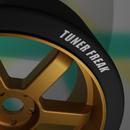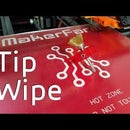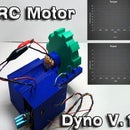Introduction: Valve Spring Soldering Iron Holder
Lately I've gotten a bit tired of balancing my soldering iron on top of my helping hands device while trying to work on a project. Aside from being tedious and cumbersome it's also quite dangerous. So after a bit of digging around in the garage I came across some old valve springs and decided to build myself a stand for my iron.
More of a visual learner? Check out the video above to see these steps performed.
Step 1: Materials and Tools
I built this stand using mostly scrap materials and a few simple tools.
Materials:
- Valve Spring (chicken wire or similar can be used if you don't have any suitable springs lying around)
- Stamped Steel about .037" thick (can be found in most small appliances, computers, televisions, etc.)
- Pallet Wood (craigslist is a good place to find free pallets)
- 2 Screws (these were taken from an old tv)
- Sponge
- Wood Stain and Spray Paint of your choice
Tools:
- Tin Snips (I found these make the cleanest cut through the steel)
- Grinding Wheel and/or Sandpaper (80-180 grit)
- Drill
- Center Punch
- Tape Measure
- Router or Dremel
- Table Saw or equivalent
- Brush
- Marker
Step 2: Making the Bracket
Making the Pattern
Start by marking out a rectangle on your piece of steel. For this stand the bracket should be roughly 7/8" (21mm) wide, and 3" (76mm) longer than the width of your base. This is to allow for an additional 1.5" for the iron to hang down. Adjust as necessary if your iron is longer and/or your spring is shorter. Next, make a mark about halfway down the length of the rectangle for a 3/8" wide, 1/2"-3/4" long tab. This will wrap around the bottom of the spring to keep it in place.
Cutting
The easiest and cleanest way to cut the steel is with a pair of tin snips. I originally tried cutting it with a cut off wheel on a Dremel, but it took seven disks and didn't leave a very clean edge.
Clean Up
After cutting out the pattern, regardless of which method you used for cutting you'll still be left with a bit of a jagged edge. This can be taken care of using a grinding wheel, steel file, or some rough sandpaper. Make sure to remove any and all burrs and round off any sharp edges.
Drilling
Next you'll need to drill a hole in the center of the pattern to allow the iron to poke through. While the size of the hole will depend on your particular iron, I used a 3/4" bit to start and used a step bit to drill the hole to the right size. Using a center punch, make an indent in the center of the pattern, just below the tab. This will keep the bit from walking as you start drilling. It's also a good idea to use a bit of lubricant to prevent the bit from getting too hot and dulling. I didn't have cutting fluid available, but found that a drop of pneumatic tool oil worked quite well. Again, make sure to deburr after drilling.
Bending
Slip the bottom of your spring over the center of the pattern and mark where the first two bends need to be made. Note that the spring will likely not be perpendicular to the pattern, therefore you'll need to adjust the angle and length of each leg accordingly. This is more of an art form than an exact science, so trial and error is the name of the game. Steel does not fatigue easily so take your time and make adjustments until you are happy with the result.
Once the legs have been bent, slip the spring onto the bracket once more and test fit your iron. Mark just below the tip of the iron. This where you'll bend the feet of the bracket. Be sure to make the legs long enough to accommodate a screw on each leg to secure the bracket to the base.
Finally, you'll need to twist the feet slightly to give the bracket a slight forward lean. Again, this will take some time working the metal to get the desired shape. One of the simplest ways to achieve this is to secure the bracket by one of the feet in a bench vise, slowly turning the rest of the bracket with either a pair of pliers or a soft mallet. Remember to orient the bracket so that the tab is facing the back of the stand.
Finishing
Drill two more holes in the bracket, one on each foot, for the fasteners to secure the bracket to the base. Finally, clean off the piece using wax and grease remover, carb cleaner, or glass cleaner to remove any residue. I then gave my bracket a coat of brown hammer finish paint before moving on to the base.
Step 3: Making the Base
Preparation
For this project I chose to use a piece of wood off of a used pallet. While any kind of wood can be used, I recommend a piece measuring no smaller than 4" x 3" x 5/8". Before doing anything else, make sure your piece is square. This is best done using a table saw. With the piece squared up, we'll need to make sure the base is smooth and free of splinters. This can be done using sandpaper between 180-300 grit depending on how rough the wood is. The idea is to clean up and smooth the piece without removing excessive amounts of material.
Drilling and Cutting
Once the base is smooth you'll need to drill pilot holes for the screws. This will prevent the wood from splitting when driving the screws and is especially important if using a cheaper wood such as pallet wood. You'll need a drill bit with a diameter about the same as the shank of the screw (the solid portion inside of the threads). Using the bracket as a template, line the bracket up with the back of the base and drill two shallow holes to match up with the ones in the bracket. Remove the bracket and drill the holes to the length of the screws. Check that the diameter of the holes is correct by threading the screw into the hole by hand. The screw should start easily and become difficult to turn after about three turns.
Next, we'll need to make a cut out for a sponge. While this is optional, it will make it easy to clean the iron while in use. In my case I made a cut out measuring 1" x 2" x 3/8", just be sure to leave at least about 1/2" on all sides to prevent the wood from splitting. The quickest way to make the cut will be with a router and straight tip cutting bit. A Dremel and sandpaper can be used to square up the corners and smooth the cut out.
Staining
With the cut out made, the final step is to stain the base. Not only does the stain improve the look of the base, but it also protects the wood. Using a brush, apply a coat of stain to the base. Note that it doesn't take much to cover a small block. Allow to dry according to the instructions for your particular stain.
Step 4: Putting It All Together
Installing the Spring
Once the paint and stain have dried, it's time to assemble the holder. Slip the spring over the bracket and begin wrapping the tab around the spring. To start, a pair of slip joint pliers works best, but once the tab is bent about 180 degrees around the spring you'll likely need to place the two in a vise and use a hammer and chisel to bend the tab the rest of the way (a screwdriver will also work as you won't be putting much stress on the driver).
Final Touches
Fasten the bracket to the base using the pair of screws you set aside. Finally, we just need a sponge to go in our cut out. Using a sharp knife, cut a dry sponge to the desired size to place in the base. Make sure the sponge fits snug in the base.
Upon first use make sure the paint that's exposed to the iron doesn't begin to burn. If it does, take a small knife or a piece of sandpaper and remove some of the paint from around the hole. So far I have not had any issues with this, but all irons and spray paints are not created equally so keep your eyes open.
Thanks for checking out my Instructable and feel free to check out some of my others!













